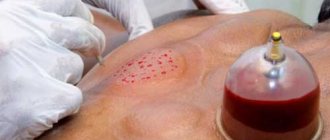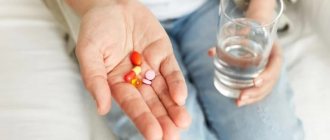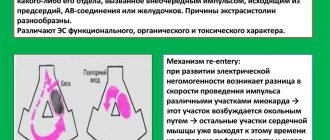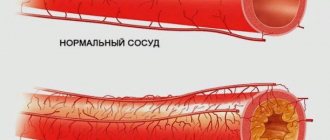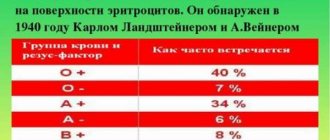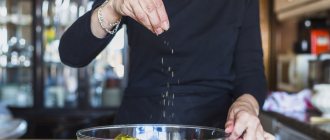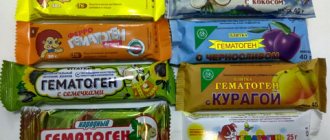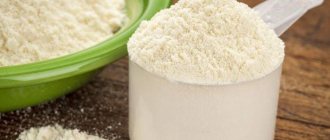Hijama is an ancient healing method associated with bleeding. It is not surprising that the term bloodletting is used as a synonym.
Interest in the hijama bloodletting procedure has only increased recently. Today our portal about vacuum massage Medbanki will tell you what it is, what the history of the method is and how best to use hijama.
The health of the body largely depends on blood supply, because blood delivers nutrients and oxygen to tissues, promoting regeneration, cleansing of poisons and renewal . Today, folk healing methods that also affect the circulatory system are gaining popularity again.
Hirudotherapy, vacuum cupping massage and hijama, the history of which goes back to the deep past, improves blood circulation.
History of the method
The first mention of bloodletting dates back to 1550 BC . In the oldest textbook on medicine, the Egyptians wrote about this method, so traditionally hijama is considered an Arabic folk method of treatment .
Al-Razi, Avicenna and other famous representatives of medicine of ancient times wrote about bloodletting. The method very quickly gained recognition all over the world, and now its relevance has not diminished at all.
In Muslim society, hijama is held in special esteem . It is considered an ancient prophetic practice, so it is seen not only with a healing, but also a religious meaning. The fact is that Muslims find a call for this method in 28 hadiths - reliable legends about the life of the Prophet Muhammad .
In Islamic areas of Bangladesh, Hijama was called "Shinga", but was practiced mainly in rural areas. The attitude of Muslims towards this technology is ambiguous. Some call it the authentic Sunnah of the Prophet Muhammad, while others associate the technique with witchcraft, for which Allah punishes without hesitation.
Bloodletting as a healing method was used in Europe, China and Arab countries, but today it is recognized throughout the world. Hijama is experiencing a renaissance, with famous personalities being treated using this practice, and special centers and clinics offering therapy are appearing in Western countries.
Various companies and practitioners use this method in Malaysia, the Middle East, Turkey, USA, UK, Russia.
Khabib Nurmagomedov uses hijama
During hijama, auxiliary tools are used, and the main one is jars. By the way, vacuum therapy can be used at home. Since the method originated in Muslim countries, special terms are used in this type of medical art:
- Hajam is a person who provides treatment.
- Bazgh - applying small wounds-incisions to the skin to achieve maximum effectiveness.
- Mikhjam is a tool used to make cuts.
- The procedure is now called phlebotomy.
Back treatment
With osteochondrosis, a person experiences unpleasant sensations, severe pain, and loses beautiful posture. To get relief, many people agree to have a blood release session. There were many cases when a person received healing even with a spinal hernia.
With the help of cupping, lymph stagnation and inflammation are removed, and muscles are relaxed from spasms. Stiff muscles come to life, the spine becomes straight and healthy. There were cases when even old diseases were cured. The jars are placed on the back along the spine, then an incision is made under each jar. Bad lymph makes way for new life-giving fluid.
The Sunnah contains a description of each point, so experts act according to a scheme that has been proven for many centuries.
What are the benefits of hijama?
Of all the liquid biological media of the body, blood is the most important, because it supplies cells and tissues with oxygen, nutrients, minerals, and vitamins. In addition, it transports hormones and removes metabolic products - a kind of waste in the body .
Blood has an unpleasant property - to stagnate. Due to vascular diseases, their narrowing, pinching of blood vessels by organs and bones (vertebral artery syndrome, pregnancy), varicose veins, high levels of sugar and “bad” cholesterol, a sedentary lifestyle and poor nutrition, blood stagnation occurs, which leads to premature blood loss. aging, hypoxia and “starvation” of cells.
That part of the blood that is not used and is stored in special reservoirs until needed (bleeding, injury, oxygen starvation) does not provide any health benefits. This blood can be considered dirty, so it needs to be renewed from time to time.
During the procedure, a certain amount of stagnant blood is removed from the body, and internal mechanisms trigger the formation of new, complete blood, which is rich in enzymes and oxygen.
Operating principle
The body has a special hematopoietic system. Its main mechanism is the formation of blood cells in the bone marrow. When some of the blood is drained out naturally or artificially, as in hijama, the reservoir receives a signal to restore the missing blood.
the renewal of blood is not felt by a person, but there is an improvement in well-being, healing and recovery. It turns out that hijama acts as a trainer for the circulatory system, cleanses the body and renews it.
Hijama is used for preventive and therapeutic purposes.
Indications
The list of diseases in the fight against which bloodletting is effective is extensive. This healing method is used for the treatment and prevention of gynecological disorders, diseases of the cardiovascular system, problems with the musculoskeletal and muscular system, ENT diseases, various infections and inflammations. The procedure is also often used in sports and even for weight loss.
Olympian "Sonny Bill" Williams
Incomplete list of pathologies. What does hijama treat?
- radiculitis;
- gastritis, stomach and duodenal ulcers;
- headache, migraine;
- pharyngitis;
- osteochondrosis;
- seizures and epilepsy;
- hearing loss;
- conjunctivitis;
- paresthesia;
- shingles;
- hypertension;
- asthenia;
- atherosclerosis;
- allergy;
- amenorrhea;
- diseases of the liver, kidneys, gall bladder;
- varicose veins;
- toothache;
- elevated body temperature due to acute respiratory infections;
- fever;
- meningitis;
- initial bleeding;
- rhinitis;
- sepsis;
- digestive disorders;
- neuritis;
- sleep disorders and depression;
- rheumatoid arthritis;
- haemorrhoids;
- rheumatism, gout;
- prostatitis and impotence;
- lymphangioma, lymphangitis;
- fistulas;
- stroke;
- joint problems.
Depending on the diagnosis, the appropriate type of hijama is selected: Tibetan, Chinese or Islamic methods.
Contraindications
Diseases and conditions for which this method is contraindicated:
- decreased hemoglobin level;
- hypotension;
- anemia and leukemia;
- thrombosis;
- oncological diseases;
- reduced number of blood cells (erythrocytes and platelets);
- severe form of heart disease (exception - concomitant heart failure);
- pregnancy and lactation, as well as 40 days of the postpartum period;
- severe form of atherosclerosis;
- age less than 20 and more than 70 years;
- severe mental disorders;
- low hematocrit.
These features are absolute contraindications. In addition to them, a special group consists of relative or temporary contraindications:
- severe post-operative or post-traumatic period (except for cases where hijama is indicated for accelerated recovery);
- situations of serious blood loss;
- recent acute respiratory infection or flu (at least 14 days must pass from the moment of recovery);
- any types of intoxication;
- menstruation and the first 7 days after it.
Before scheduling a person for a session, professionals may require examinations (a complete blood count) and provide a medical record, as well as other diagnostic results, depending on the indications. For example, for cervical osteochondrosis, a specialist may need an MRI result of the cervical spine.
Modern approach
Nowadays, the treatment of mental disorders follows the rules of complex therapy, focusing on syndromic manifestations, taking into account the duration and progression of the process. Each case requires an individual approach, taking into account the characteristics of the patient and his environment, and the sequence of application of methods.
Despite the fact that methods for relieving such disorders have made great progress, there are still some problems in their implementation. First of all, this is due to the fact that it is still not possible to establish the causes of many mental illnesses. Secondly, today psychogenic diseases are tirelessly progressing, acquiring new forms.
Since the human brain and psyche are the least studied areas, they present many “surprises”. And you can never be sure that the disease will go away forever.
Conventionally, the principles of treatment of mental disorders can be divided into biological therapy and psychotherapy .
Biological therapy combines methods that address the biological causes of the disorder. The most famous of them:
- pharmacotherapy;
- efferent therapy;
- electroconvulsive;
- insulin shock;
- narcopsychotherapy.
Pharmacotherapy
This method is the basis for the relief of mental disorders. Its functions are:
- elimination of the acute period of the disease in a hospital setting until remission occurs;
- stable use of medications as relapse prevention in a hospital or outpatient setting;
- maintenance therapy to achieve stable remission.
Taking medications can eliminate pathological symptoms and stop the progression of the process.
Among psychotropic drugs , there are several classes that affect a specific group of symptoms:
- antidepressants;
- tranquilizers;
- neuroleptics;
- mood stabilizers;
- nootropics;
- psychostimulants.
Antidepressants act on depressive symptoms; such drugs include both stimulants and sedatives. On the one hand, they stimulate a person to activity, eliminate apathy, lack of will, gloomy thoughts and a decadent mood, and on the other hand, they relieve anxiety and calm. Representatives:
- amitriptyline;
- Prozac;
- Azafen.
There are several generations of antidepressants, each subsequent of which is more effective and less traumatic.
Tranquilizers perform 5 main actions: relieve anxiety, calm, normalize sleep, promote muscle relaxation and exhibit an anticonvulsant effect. But not all products in this group have all of the listed properties. Each class of tranquilizers “specializes” more in several of them. In addition, there are those that exhibit an activating effect. Indications for use are neuroses and various types of anxiety disorders. Representatives:
- Tofisopam;
- Seduxen.
Neuroleptics are prescribed when psychopositive symptoms appear in the clinical picture of the disease: delusions, hallucinations, mania, distortions of behavior and thinking, aggression. Indicated for psychosis. Representatives:
- Risperidone;
- Amisulpride;
- Haloperidol.
Normotimics. Drugs in this group normalize mood and prevent its polar fluctuations. Accordingly, manic-depressive psychosis becomes a direct indication for their use. These include:
- lithium preparations;
- Depakine;
- Lamotrigine.
Nootropics improve the metabolism of brain tissue and restore cognitive function. Therefore, they are widely used for mental disorders accompanied by changes in cerebral circulation, atherosclerosis of cerebral vessels: dementia, neuroses, alcoholism, vegetative-vascular dystonia, etc. Representatives:
- Piracetam;
- Phenibut;
- Nootropil.
Psychostimulants activate mental activity and increase motor activity. Relieves lethargy and fatigue. Indications: apathy, asthenia. Representatives:
- Sidnocarb;
- Caffeine.
Psychotropic drugs are prescribed exclusively by a doctor and require careful dosage adjustment. Some of their effects become a big problem on the path to healing.
Many such drugs have a list of side effects that are difficult for patients to tolerate. Scientists are trying to improve their formulas, developing new generations of drugs that are more advanced and gentle in their action.
Another problem is the development of dependence or, conversely, resistance to their effects. In addition, they require long-term use, and sometimes it is difficult to choose the appropriate remedy and dosage.
All these nuances lead to the fact that patients often refuse to undergo treatment, abandoning it halfway. This becomes a huge step backward and negates the positive results achieved.
Efferent therapy
This method of biological therapy involves purifying the blood and improving its parameters. Its methods include:
- Plasmapheresis is taking blood from a patient and dividing it into plasma and blood cells. The cells are subsequently returned to the patient and the plasma is replaced by intravenous solutions.
- Cryoplasmapheresis - plasma is detoxified and returned to the patient.
- Hemosorption, plasma sorption - plasma or blood is passed through sorbents;
- Hemofiltration is the purification of blood in a special filter.
- Thermofiltration - enhancing hemofiltration properties by heating.
- Hemodialysis or an artificial kidney machine is used to remove toxins from the blood if the patient's kidneys do not work on their own.
- Ultraviolet irradiation of blood.
- Laser irradiation of blood.
The methods listed above have a detoxifying, regenerating and immunostimulating effect on the body. As a result, during the treatment of mental disorders it is possible to achieve antidepressant, antipsychotic and psychostimulating effects.
This procedure is indicated for particularly toxic disease. For example, this applies to febrile schizophrenia, a form of disorder accompanied, in addition to the main symptoms, by oneiroid-type changes in consciousness and autonomic disorders. Its main symptom is fever. Moreover, it does not fall under the typical temperature curve characteristic of somatic diseases. The appearance of bruises and the development of cachexia, that is, exhaustion, are possible. Delusions and hallucinations during this period reach their peak and are malignant. Catalepsy is observed - the so-called waxy flexibility, when the patient takes on any shape given to him.
Other conditions requiring efferent intervention include:
- poisoning with narcotic and pharmaceutical drugs, poisons;
- delirium of various origins;
- hallucinatory syndromes that cannot be controlled with medication.
Other biological therapies
These include shock treatment methods: insulin comatose and electroconvulsive therapy.
Shock insulin therapy is, as already mentioned, the administration of increased doses of insulin. They are increased gradually, bringing the patient first to hypoglycemia and then to coma. The course includes up to 30 procedures.
The patient is brought out of coma by administering glucose solutions. The method involves stimulating the body's adaptive mechanisms under shock conditions, so that it can resist the disease.
This method is contraindicated for infectious diseases, liver and kidney failure, endocrine pathologies, as well as during pregnancy, heart pathologies and cancer.
Electroconvulsive therapy is used extremely rarely in cases where drug treatment does not bring results. It is usually used for patients with febrile schizophrenia and severe depression. Previously, the patient undergoes a thorough examination.
The method involves exposing the patient to an electric current discharge, causing convulsions. It is assumed that in this way the subcortical centers of the brain are stimulated. It is allowed to use up to 10 sessions of such therapy.
Surgical methods of treating mental disorders are resorted to in cases when all other methods of therapy become ineffective. The duration of the process (5 years or more) and the patient’s disability are also used as arguments. The main criterion for surgical intervention is the presence of a structural target, that is, an established organic cause of the disease.
Cosmetic hijama
There is a wide demand for this procedure among girls and young people who are puzzled by the condition of their skin and appearance in general. Here hijama is used for cosmetic purposes to maintain health and beauty.
Cosmetic aspect
The method is effective for the following problems:
- acne;
- acne;
- boils;
- swelling;
- skin pigmentation;
- cellulite;
- excess weight;
- stretch marks;
- skin irregularities (scars, scars);
- lack of collagen and elastin;
- disturbances in the functioning of the sebaceous glands;
- wrinkles;
- loose skin.
Cosmetic hijama for women is a salvation when the need arises for:
- smoothing the skin;
- renewal of blood fluid;
- restoration of the dermal matrix;
- activation of the production of hyaluron, collagen and elastin;
- destruction of melanin;
- getting rid of age spots.
The effect is visible after the first session, but as a result of the course of treatment, which is selected individually in accordance with the initial condition, you can achieve weight loss and complete renewal of the skin of the face and body.
Advantages and disadvantages of the method
Maximum effectiveness is achieved when treatment is performed using Islamic or Chinese techniques . Violation of the integrity of the skin leads to drip bleeding, as a result of which stagnant blood leaves the body and hemostasis is activated.
Drip bleeding
After just 3 seconds the following happens:
- blood vessels become clogged;
- nerve endings become irritated;
- the signal is sent to the spinal cord;
- nerve impulses travel to the tissues of this area;
- new blood begins to fill empty reservoirs and vessels.
Chinese, Islamic and Tibetan hijamas help to get rid of “bad” blood with a large accumulation of toxins. European technology cannot boast of such an effect. When performing the procedure using this technique, only part of the blood is removed out. This is why negative results more often occur with European hijama:
- the immune system is temporarily weakened;
- the volume of oxygen supplied decreases.
Harm from bloodletting can occur in several cases associated with ignoring contraindications, low qualifications of a specialist, improper training and technique, and unsanitary conditions. The procedure will be useless or dangerous if the technician does not know the location of the biologically active points.
Classifications and types of hijama
Types and subtypes:
- According to the method of execution: dry and wet .
- By area of influence: general and local .
- According to the specifics of execution: Islamic, Tibetan, Chinese and European .
- By type of bleeding: capillary, venous and large venous .
Dry hijama is performed without prior piercing or incision of the skin . Jars are placed on the area treated with massage oil to create a vacuum. This technique is known as vacuum cupping .
In wet hijama, incisions or punctures are made using a special needle to cause capillary bleeding . then pumped out using vacuum cups . In this sense, hirudotherapy also refers to bloodletting.
Installation of vacuum cans
The general type of bloodletting involves placing cups on the entire body. This method is used to prevent or treat vascular diseases.
, individual areas of the body are exposed . For example, with osteochondrosis there is a need to install cups only on the back, with varicose veins - only on the legs .
Chinese bloodletting
This is a traditional Chinese non-drug method of treatment and prevention, which is developed in accordance with the standards of ancient Chinese medicine. The method is similar to acupuncture, since the process affects points that it is desirable to activate or weaken.
With the Chinese bloodletting technique, small incisions are made on the skin - strictly in the places where the capillaries are located. The goal is to activate capillary bleeding.
During the session, blood loss is so insignificant that the risk of bleeding or complications from the circulatory system is minimized.
Tibetan bloodletting
It has much in common with Chinese, but also has characteristic features.
- First, the technician induces venous bleeding by making an incision in the wall of the selected vein.
- Secondly, the points of influence in this case are located in different parts of the veins, and not on the meridians along which the qi energy flows (as the Chinese think).
- The rest of the procedure is carried out in a similar way: cups are installed that suck out the stagnant blood.
Islamic bloodletting
If you go deeper into history, it can be called hijama. During the session, the doctor makes small incisions at certain points and always uses cups. This is the main difference between the Islamic technique and the Chinese, in which sometimes the blood is squeezed out manually, without resorting to the use of medical cups.
Famous showman Calum Best
Another difference between hijama and Chinese and Tibetan techniques is the lack of a theoretical basis. Muslims never seek scientific confirmation of what the Prophet said. They do not talk about any energy, clusters of nerve endings, but simply place the jars on certain points. For this reason, Islamic bloodletting does not require special indications. For any diagnosis, a specialist can select any points without making logical connections between the location of the point and its connection with the internal organs.
European bloodletting
It reached the peak of its popularity in the Middle Ages, but has now lost its relevance due to low efficiency. Now this method is used only in cases where more modern methods do not lead to the desired result.
In European phlebotomy, an incision is made into a large vein, resulting in large blood loss. The method can be compared with modern blood donation from the cubital vein .
Use of the method in the Middle Ages
Classification according to the last sign (type of bleeding) is closely related to the type of bloodletting:
- Capillary bleeding is characteristic of Chinese and Islamic bloodletting;
- Minor venous bleeding - for Tibetan;
- Large venous - for European.
Fever and fashion for leeches
Since excess blood was considered the cause of overheating and intensification of the fiery principle, bloodletting was a way to “ventilate the veins” and “cool” the hot body. It was considered indispensable for fevers: these included many diseases accompanied by fever, rapid pulse and heartbeat - from colds to inflammation of internal organs. This connection between symptom and treatment was extremely stable. At the beginning of the 19th century, the French military doctor and physiologist Francois Broussais preached bloodletting as a panacea for fevers and inflammations FJV Broussais. Histoire des phlegmasies ou inflammations chroniques fondée sur de nouvelles observations de clinique et d'anatomie pathologique: avec leurs différentes méthodes de traitement. Paris, 1808., and Brousse attributed almost all diseases to inflammation, including scurvy and cholera, new to France. Making a concession to the sensitivity of his patients, instead of a painful lancet and cups, Brousse used leeches - a person almost does not feel their bite. This is how a 30-year-old fashion for leeches arose in Europe, the damage from which was compared by caustic contemporaries to the Napoleonic Wars. The leeches themselves also suffered: by the 1830s, the worms of the Hirudo medicinalis variety in Western Europe had practically run out, and they had to be imported.
Leeches. Illustration from the book “Physica sacra” by Johann Jacob Scheichzer. 1731–1733 Wellcome Library, London
Benefits for humans
Any bleeding is stress for the body, but in this case it is useful. During hijama, old blood containing toxic substances leaves the body. microcirculation and lymph flow improves in tissues, cells receive nutrients and oxygen.
Nerve endings are freed from excess pressure, which was exerted by various accumulations of blood and swelling, so false impulses are no longer sent to the brain.
Showman Calum Best at a session
Clinical picture of changes:
- The blood thins out.
- The risk of blood clots is reduced.
- Blood microcirculation improves, congestion disappears.
- Inflammatory processes stop.
- Pain and tension in the muscles disappear.
- Immunity is strengthened.
- Fat deposits are broken down.
- Atherosclerotic plaques are broken down.
- Blood glucose levels are normalized.
- Swelling disappears.
- An antiallergic effect appears.
- Blood pressure decreases.
- Lymphatic drainage occurs.
The benefits of European bloodletting are much lower, since activation of local regulatory systems does not occur . It is advisable to use this technique only if there is a threat to life due to the large volume of circulating blood (during hypertensive crisis, pulmonary edema, etc.).
Possible consequences
The benefits and harms of bloodletting (hijama, Chinese techniques, etc.) are determined by the presence/absence of restrictions on the session. Ignoring existing contraindications can lead to a significant worsening of the disease, a critical drop in blood pressure, and even fainting. In addition, the functioning of the heart may be impaired. We should also not forget about the risk of infection if a specialist does not comply with sanitary standards.
How to do hijama?
The procedure does not take much time and does not require regular frequent repetitions. From the patient’s arrival at the center to the end of the procedure, usually no more than 40-60 minutes pass, taking into account all preparatory measures.
The course of treatment is determined by a specialist based on the diagnosis , taking into account the chosen technique and the area of the treated area. As a rule, 3-5 sessions 1-2 times a week are enough to improve your health.
To prevent and prevent relapses, the course of treatment should be carried out 2-3 times a year.
What kits are used?
Practice is carried out only in special clinics and centers where the necessary instruments are available and sterile conditions are observed . In addition, the technician can only be a trained specialist who will not make mistakes either in the methodology or in determining the points.
Set for medical practice
The standard kit includes rubber gloves, antiseptic, sterile paper wipes and bandages. The two main tools are special jars and devices for puncturing (cutting) the skin.
Surgical scalpel with replaceable blades
The latter include:
- thick needles;
- triangular needles;
- triangular knife-hanuur in the form of a pike;
- scarifier type lancet;
- Hanuur hatchet (only for the Tibetan type).
Ancient and modern devices with needles
After performing the procedure of punctures or incisions, there is a need to install blood-sucking cups. Most often, a special set of cylindrical plastic vessels with a device for pumping air from above is used . Typically, experts opt for cans of Chinese or Korean origin.
If such a set is not available, ordinary glass jars may be suitable. The difficulty of their use lies in the need to pre-burn out the air using cotton wool soaked in alcohol.
Features of the procedure
- A woman performs a procedure on a woman, a man on a man.
- Favorable days for hijama: Monday, Tuesday, Thursday, unfavorable day - Wednesday.
- Hijama should be performed on the 17th, 19th and 21st of every month.
- This method of treatment is carried out only on an empty stomach.
Hijama is especially successful on auspicious days
What should you do before bloodletting?
Hijama does not require any special preparation, but Muslims insist that the method is effective only if the rules are followed:
- The patient must set himself up for success : a skeptical attitude reduces the effectiveness of any method.
- It is necessary to make sure that the specialist has the proper arsenal of skills and abilities, has experience and appropriate education.
- The last meal is allowed no later than 3 hours before the procedure.
- Shortly before bloodletting, you can drink water or natural fruit juices.
- The doctor should be warned about the presence of all existing chronic diseases , recent allergies, acute respiratory infections and infections. It is especially important to report HIV, hepatitis, syphilis and other infections that require special precautions.
Stroke treatment
Stroke takes many lives or leaves people disabled. It turns out that the ancient method can help you recover. Keep a syringe at home to help the sick person. When someone has a stroke, prick all 10 of their fingers until red liquid comes out. Squeeze it out well.
Then massage your ears until they become red. If it doesn’t help, then prick your earlobes until blood appears. This method has saved more than one patient. After this, the patient must be taken to the hospital.
Dear friends, reviews about the ancient healing method are the most positive. If you have the opportunity to undergo such treatment, then you are in luck! The main thing is that the manipulation should be carried out by an experienced specialist and only with disposable devices. Watch this closely!
Also on our website you can read: Tibetan gymnastics in bed for active longevity.
How is the procedure performed?
Chinese
The impact occurs in two ways using traditional instruments made in China or Mongolia:
- drip bloodletting using a triangular needle;
- cupping using a lancet and further installation of blood-sucking cups.
The technique of capillary Chinese bloodletting begins with sterilization of the instrument. The patient takes a comfortable position, which is determined in accordance with the area of influence, the doctor presses the index finger of his left hand on the skin in the area of the point and makes a puncture with a quick movement. The needle is taken in the right hand.
The puncture depth does not exceed 1-2 mm. Then the doctor gently massages the puncture site so that droplets of blood appear on the surface of the skin. In the same way, the master treats all suitable points, waits for blood clots to form and applies an antiseptic solution to the wounds. This ends the session.
The patient needs to lie down in a relaxed state for 15 minutes, then you can begin your normal activities, avoiding eating heavy foods and strenuous physical activity.
The cupping technique is carried out according to a similar scheme with some differences:
- the puncture depth can reach 2-3 mm, with a large amount of subcutaneous tissue - 4-5 mm;
- after the puncture, the skin is lubricated with vegetable oil to install blood-sucking cups;
- the jars are placed over the punctures, and the skin is absorbed into them by 1-3 cm;
- the cups are kept on the patient’s skin until blood stops flowing;
- rest time after hijama increases to 20 minutes.
After removing the cups, the doctor should apply a sterile bandage to the injured area.
Tibetan
Tibetan bloodletting is carried out after a number of preparatory procedures:
- You must first drink a decoction of medicinal herbs;
- the best time for hijama according to the Tibetan method is before 12 noon;
- The skin should be pre-washed with warm water.
The skin at the incision site is treated with an antiseptic. The vessel that will be exposed is selected in advance. A tourniquet is applied just above the incision site, then the doctor slowly squeezes it until a feeling of numbness appears. The skin is carefully rubbed and cut with a hanuur hatchet.
When bleeding starts, the tourniquet is not loosened. The doctor carefully monitors the flowing blood and waits for the bleeding to stop. Typically, 30-50 ml of blood comes out during manipulation.
The danger is a situation in which thick, oily blood flows out. This means the procedure must be stopped.
The final stages of the procedure are removing the tourniquet, massaging the wound, treating the incision site with an antiseptic, applying a cold object and fixing it. Rest time is 15-20 minutes.
Islamic
The instruments are first sterilized, and the skin is treated with warm soapy water and an antiseptic. The patient takes a comfortable position.
Blades
The procedure itself is carried out in three stages:
- installation of cups to bring blood to the skin;
- making lancet incisions 2-3 mm deep and 3-4 mm long;
- re-insertion of blood cups.
After the bleeding has stopped, the cups are removed, the skin is treated with an antiseptic and a sterile bandage is applied.
Islamic method
The method of European bloodletting is no different from taking blood from a vein, so there is no point in describing it in detail.
Humor theory
In the European tradition, the idea of the benefits of bloodletting goes back to the ancient doctrine of humors and temperaments. According to Hippocrates, the human body was governed by the ratio of four vital juices (humors) - blood, phlegm, yellow and black bile. Humors, in turn, correlated with the four elements (fire, water, earth and air) and the movement of the heavenly bodies. Thus, a correspondence was established between the macrocosm and the microcosm, the Universe and the human body, and order and health were understood as the balance of the elements. In the human body this balance was expressed as the balance of humors. An imbalance entailed illness, excess and passion - and, conversely, a bad regime and vices caused an imbalance. Diseases were explained by acute, chronic or hereditary excess of one humor and deficiency of others.
Of the four humors, the greatest attention was paid to the quantity and quality of blood, in which all four elements were combined and balanced. The blood should not be too hot (this indicated an excess of the fiery principle) or too cold (excess water), too viscous (excess earth) or too liquid (excess air). According to the ideas of doctors of Antiquity, blood was created by the body from food and served as a building material for meat and bones. Hence the diet was based on the consumption of meat and neglected greens and vegetables, which were considered useless.. A lack of blood was harmful, but an excess was much more dangerous, and bloodletting became a way eliminate this excess.
Tips after the procedure
Once the patient has left the treatment room, hijama cannot be considered completed . At this moment, important renewal processes in the body begin; a good effect can be achieved by following certain rules:
- It is better to refrain from eating for 2 hours after the manipulation.
- It is recommended to quit smoking and drinking alcohol for 7-10 days.
- Since the body is in a stressed and weakened state, it is necessary to provide it with peace and refuse physical activity and active housework. It's better to come home and go to bed.
- You should not eat heavy foods on the day of the procedure, especially meat and dairy products. Eat cereals, fruits and vegetables.
- It is advisable to protect yourself from stress and nervous tension: do not worry, do not watch the news, do not read.
- Under no circumstances should you overcool or allow wounds to be exposed to wind (fan, air conditioner, draft).
after some time, adverse reactions may occur, such as a slight increase in temperature, dizziness, nausea and diarrhea. This is a normal physiological reaction associated with the activation of immune forces.
Contraindications
According to doctors, the harm of bloodletting outweighs the benefit if the patient suffers from the following ailments:
- Persistent hypotension.
- Hemophilia.
- Heart defects (even uncomplicated).
- Thrombophlebitis.
- Chronic atherosclerosis.
- Viral hepatitis.
- Severe anemia.
- Mental disorders.
- Exhaustion.
This procedure is strictly contraindicated for children, persons over 65 years of age and pregnant women. Phlebotomy is also not done within a month of injury. Women need to wait 1 week after completing their menstruation.
Are there differences in treatment for men and women?
Hijama is in demand among women because they are more careful and responsible about their health. However, the method helps everyone equally.
The method is in demand among women
There is an opinion that women do not need to have bloodletting because they bleed every month during menstruation . This opinion is erroneous, since menstrual blood has nothing to do with the general cleansing of blood vessels and reservoirs . In addition, bloodletting was previously indicated for infertility and it successfully solved this problem.
Recommended for the fair sex in the fight against the following conditions:
- eye problems;
- gynecological diseases;
- intestinal colic;
- stomach pathologies;
- decreased immunity;
- for the purpose of losing weight.
For men, hijama is indicated for prostatitis, male infertility, impotence, increased sperm viscosity, decreased libido, and work in hazardous industries.
Hijama points
With hijama, punctures and bloodletting occur at strictly defined points. There are a lot of them, and they are all indicated on a special atlas of points for hijama. One of the main points in Islamic methodology is called al-kahal. It is located at the center of the nerve endings that connect the brain to all other parts of the body.
Point 1 - al-kahal, points 43 and 44 - al-ahdayen (al-ahdayeen)
The second most important point is al-Ahdayen (al-Ahdayeen). It is located where blood supplies the brain - in a vein in the neck.
The point atlas has been used for thousands of years. Their location completely coincides with places where large amounts of energy accumulate . In China, massage and any other effects on the points were accompanied by pain and unpleasant sensations in one of the internal organs.
At the same time , searching for points in accordance with the location of energy meridians is a very complex and long process, and hijama according to the sunnah and the scheme are no less effective, but simpler.
Since there are so many points, they are classified into several groups depending on the disease. Each point can be treated either only with a dry or only with a wet method . In some cases this doesn't make any difference.
Diagnoses
Hippocrates recommended bloodletting for colds, wind, sudden loss of speech, gangrene, dropsy with cough, cracks in the skull, swollen testicles, pain and rumbling in the abdomen. Galen added apoplexy (stroke) and migraine to this list. Doctors of the Middle Ages supplemented the ancient recommendations with a list of new diseases (including epidemic and mental) and summarized the accumulated knowledge in the form of tables and diagrams. They depict a human body with marks from where and how to bleed in a given case. Each disease had its own protocols - according to the place and nature of bloodletting, the number of procedures and the volume of blood released: it could vary from several ounces. An ounce is a unit of measurement of the mass and volume of liquid bodies. A Russian ounce was equal to approximately 28 grams. to the plates. The choice of the location of the incision depended on whether the disease was associated with the brain, heart or liver - in the Hippocratic bodily model, three centers of sequential control of nerves, arteries and veins. In turn, the purpose of bloodletting could be to extract “bad blood”, to divert or draw blood away from a diseased part of the body, or, conversely, to stimulate blood flow to a sore spot or organ. In addition to the actual therapeutic effect, bloodletting was attributed to a preventive effect: it was believed that it mobilizes vital energy.
Illustration from a reference book on practical medicine. Germany, 16th century Wellcome Library, London
Adverse reactions
Sometimes during or at the end of the session the patient begins to feel unwell. In this case, you should stop the procedure, although the causes of adverse reactions are usually not dangerous.
- Weakness and a small amount of blood is usually associated with the patient’s strong fear or a large amount of waste and toxins.
- Elevated temperature after the procedure is a favorable symptom. This means that the body has turned on its defenses.
- A wet cough means that all harmful substances are leaving the body.
- Loss of consciousness is a common occurrence and is also associated with the activation of immune forces.
- An exacerbation of the disease for which a person is being treated means that recovery from it has begun.
Oddly enough, if a person does not feel any changes, is still cheerful and full of strength, this is a bad signal. It means that the specialist has incorrectly identified the points and the body does not react to the procedure in any way.
Interesting Facts
Reviews about this method are also given by representatives of official medicine - doctors who know the results of laboratory studies of hijama.
The composition of the discharge differs from the norm
- The blood removed during the bloodletting was sent for laboratory analysis, which showed that the number of red blood cells in it was not normal.
- Hijama improves liver function. The test involved a patient diagnosed with stage 1 liver cirrhosis. The course of treatment helped to completely get rid of the disease.
- One of the patients showed changes after several bloodletting sessions, namely: decreased blood sugar levels, normalized cholesterol levels and decreased triglyceride concentrations.
- In Europe, an experiment was conducted on rats: the animals were injected with a lethal dose of strong poison, then immediately bloodletted. All rats remained alive.
- In the 18th century, scientist Zihni Kiraly also conducted an experiment with rats. He injected the animals with strychnine, placed dry jars and discovered that the animals were alive. As soon as the cans were removed, the rats died. A similar experiment with wet jars saved the lives of all experimental rodents.
Research on hijama by official medicine
Today, hijama is used for rejuvenation, against acne, and in the treatment of many diseases, but the question of what the technique helps with has not been resolved on its own. The benefits have been established through numerous studies.
One of the large-scale studies was carried out by scientists from the University of Damascus. The results of the experiment were evaluated by a commission consisting of 15 people. After hijama, each participant in the experiment had a decrease in blood glucose levels, an increase in the concentration of red blood cells, and a decrease in the amount of cholesterol.
French professor Luc Contel examined in the laboratory the blood of patients who underwent the procedure and other people. The results showed that in those who underwent a course of bloodletting, leukocytes produced substances responsible for immunity much more actively.
Treatment of other diseases
For varicose veins, this method is considered quite effective. A puncture is made in certain places on the skin of the legs, and a jar is placed in this place, into which bad blood flows. After a slight loss of fluid, the body begins to produce new fluid, relieving a person of many diseases.
After removing unnecessary clots in the vessels, lymphatic drainage improves, the life-giving fluid begins to be better equipped with oxygen. In addition, high pressure in the vessels, which rose due to the accumulation of blood in one place, disappears. Banks are placed on the legs and other points on the body.
Hijama points for varicose veins:
- on the back: 1, 28, 29, 30, 31, 55;
- on feet: 132.
The release of red liquid into the jars is shown in the photo. As you can see, this is a rather complex operation, therefore, it must be performed by a person with medical education.
Results
We realized that this is an old, but still relevant and effective, traditional method of treatment and healing using tools - needles or a knife, as well as cans.
Placing cans on a spatula
During the session, the patient is in a relaxed state and does not experience any painful sensations. The procedure must be performed by a hajjam, since the impact must be carried out on special points.
Indications for bloodletting (hijama, phlebotomy) are a huge number of diseases and skin defects, which is important for cosmetic hijama. The technique can be performed on people from 20 to 70 years old, provided there are no contraindications.
Hijama allows you to cope with sleep disorders, neuroses, diseases of all organs and systems. There are stories, which, however, do not have documentary evidence, that bloodletting helped cure even incurable or very serious conditions (infertility, oncology).
The procedure takes only a few minutes. For maximum effect, 1-2 repetitions per week for 1-2 months are enough . If necessary, the frequency and duration of treatment is always determined by a specialist.
Cans work wonders in the hands of a professional, so they can be installed in any area. So, popular: hijama on the face, head and delicate mucous membranes.
The body must respond with changes: nausea, weakness, fever. If your health has not changed, most likely the doctor identified the points incorrectly and the body did not receive any benefit.
The result of hijama on the head, video
Your browser does not support the video tag.
The effectiveness of hijama has been confirmed by numerous experiments and experiences, so the reviews from doctors about this procedure are extremely positive.
Read further:
- The influence of diet and lifestyle on our genes
- Mat - Lyapko applicator - quick help for the back and whole body
- Guidelines for the use of plastic massage cups
- A Simple Study on Protozoa (Part 1)
- A Simple Study on Protozoa (Part 2)
- Methods of cupping for arterial hypertension. Interview with Professor Wang Jing
- Effective cosmetic vacuum massage of face and body at home
Concept
The scientific process of bloodletting is called phlebotomy. This term refers to a technique whose essence is to remove a small amount of liquid connective tissue from the body. For this purpose, specialists make a small incision or puncture of the blood vessel.
Phlebotomy can be:
- Local. This involves performing the procedure on a small area of the body. In this case, small incisions are made or leeches are used.
- General. In this case, work is carried out over a large area. The punctures, accordingly, in this situation are made deeper.
In official sources you can find a lot of information regarding the harm of bloodletting. However, the benefits from this procedure are also significant. Even reputable doctors resort to it when the patient is in serious condition and, according to indications, it is necessary to remove about 300 ml of liquid connective tissue from his body.
Depending on the nature of the incision, bloodletting can be:
- Capillary. The specialist makes a small puncture of the skin. After this, he places a jar over the place where its integrity has been violated. Due to this, a vacuum is created, which results in stimulation of the release of connective tissue. Regarding the benefits and harms of bloodletting with cupping. The latter is reduced to almost zero if the instruments have been thoroughly sterilized beforehand. In this case, your health actually improves. If the procedure is carried out in violation of the norms, the risk of contracting various types of infections increases significantly.
- Venous. In this case, the blood flows out on its own. The outflow of liquid connective tissue occurs through an incision in the wall of the small vein. In this case, the benefits of bloodletting are questioned by some doctors. This is due to the presence of serious risks of infection.
- Big. During the procedure, incisions are made on large veins. According to doctors, there are benefits from volumetric bloodletting, but the session itself is associated with great risks. In this regard, it is recommended to perform the procedure only in licensed clinics, whose employees value the reputation of the institution.
Historically, bloodletting began to be performed almost simultaneously in several countries. Currently, 4 phlebotomy techniques have been developed. Each of them relies on the techniques and traditions of their country. The benefits and harms of bloodletting in each case are described below.

